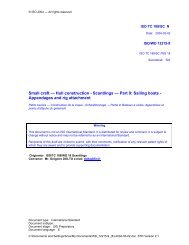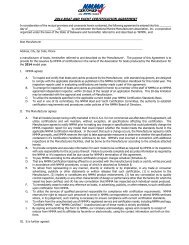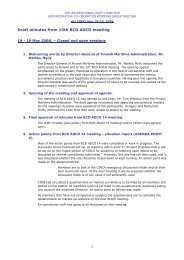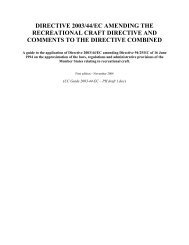global environmental legislation guide - National Marine ...
global environmental legislation guide - National Marine ...
global environmental legislation guide - National Marine ...
Create successful ePaper yourself
Turn your PDF publications into a flip-book with our unique Google optimized e-Paper software.
It also should be noted that in some countries with existing registration schemes forantifouling paints, zinc oxide is not considered a biocide 1 . The information/data presentedbelow was used to justify the fact that zinc oxide is not used as a biocide.Zinc oxide - function in AF PaintsIn antifouling coatings zinc oxide is added to the formulation to:• Regulate the dissolution of the paint film during service (i.e. control the film polishingrate)• Stabilise wet paint in the can• Modify dry film properties e.g. act as a UV absorber• Pigment the systemZinc oxide is primarily used in antifouling coatings due to its unique solubility characteristics.In addition, zinc oxide has a number of properties described in the following sections, whichare beneficial for the final antifouling formulation. To date no alternatives have been foundthat provide the equivalent solubility characteristics of zinc oxide.Regulation of dissolution of the paint film during serviceControlling the solubility of the paint film, and hence the polishing rate, is critical to theeffective performance of the paint. Zinc oxide is a critical paint ingredient used to controlthe polishing rate of the paint. Creating a paint that is too soft (i.e. poor mechanicalintegrity) when dry will mean that the paint polishes away too quickly revealing the inertundercoating beneath which will foul. In combination with the resin system chosen, zincoxide is incorporated into the film at the product design level to give the right balance ofmechanical strength and solubility to ensure that the required in service life time isachieved.Stabiliser for wet paintZinc oxide combines readily with free acid groups present in the paint, resulting in theformation of zinc soaps. The acids might, if not neutralised, react with other paintingredients and lead to the formation of an unstable wet paint. Viscosity increase or evengelation could be the result of such incompatible systems. Whilst other compounds areavailable which have the same properties of neutralising free acid groups, the solubilitycharacteristics of these compounds are not suited for use in antifouling coatings.Modify dry film propertiesZinc oxide absorbs ultra-violet light which is damaging to the stability of organic biocides andsome binder systems. For antifouling coatings this is an important issue whenever films arenot continually immersed e.g. the boot-top area, or in cases where extended dry-dockingperiods are required (such as in yacht refitting). Zinc oxide actively absorbs UV and henceprotects photo-sensitive binders and pigments from degradation by UV-light. Currentalternatives to zinc oxide do not show comparable UV-absorbing properties.1 Both the UK and Dutch authorities have reviewed the use of zinc oxide in antifouling paints under existinglocal laws and judged its use as non-biocidal. This has been communicated to individual companies withinCEPE.











